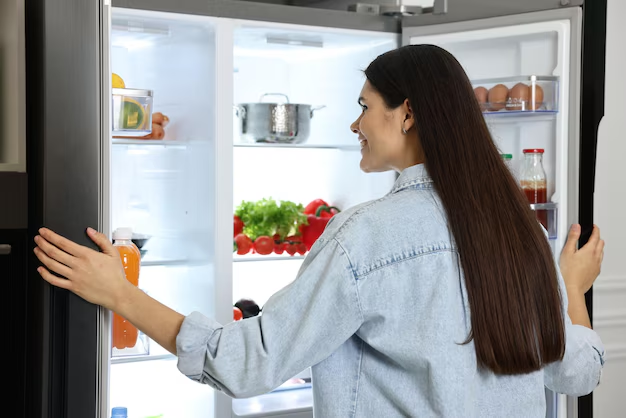What's the Ideal Temperature for Your Refrigerator?
In the hustle and bustle of daily life, the nagging question of how best to preserve food often sneaks up on us. We all want to ensure our groceries last longer, taste fresher, and stay safe for consumption. This pursuit inevitably leads to one critical aspect: your refrigerator's temperature setting. Surprisingly, a small tweak in temperature can make a significant difference in food quality and safety. Delve into this guide to grasp the ideal fridge temperature setting and uncover practical tips for optimizing your refrigerator's performance.
🥶 Why Refrigerator Temperature Matters
The temperature of your fridge is more than just a number on a dial; it's the backbone of food safety and preservation. Setting your refrigerator to the correct temperature prevents the growth of harmful bacteria, reduces food spoilage, and prolongs shelf life. Temperatures that are too low can freeze and deteriorate delicate items, while those that are too high can foster bacterial growth. Striking a balance is crucial for maintaining both food safety and quality.
Food Safety and Bacterial Growth
Refrigerators serve a fundamental purpose: to slow bacterial growth. Some bacteria can cause foodborne illnesses if foods are not stored correctly. To effectively stall this bacterial development, your fridge must remain at a steady, optimal temperature. This ensures perishables such as meats, dairy products, and produce remain safe and maintain their integrity longer.
Food Quality and Longevity
A well-maintained refrigerator temperature not only defends against bacteria but also optimizes the taste and texture of stored foods. Vegetables remain crisp, dairy retains its freshness, and meats are tender and flavorful. By staying vigilant about your fridge's temperature, you contribute to a sustainable household that reduces waste and maximizes grocery budgets.
🌡️ The Optimal Refrigerator Temperature
So, what is this magical setting that ensures food safety and quality? The sweet spot for a refrigerator is generally around 37 degrees Fahrenheit (3 degrees Celsius). This temperature ensures food remains fresh while preventing freezing in sensitive items like lettuce and berries.
Understanding Temperature Variability
While 37 degrees Fahrenheit is the goal, certain variabilities within your fridge can influence overall performance. Common culprits include refrigerator load capacity, door frequency opening, and external ambient conditions. Thus, your fridge might sometimes need fine-tuning to align with these factors, ensuring an even and consistent internal climate.
📋 Quick Tips for Maintaining the Best Refrigerator Temperature
- Position Your Thermometer: Place a refrigerator thermometer in the center to monitor temperature; adjust settings if it deviates from 37 degrees Fahrenheit.
- Organize Your Shelves: Avoid overcrowding; allow air to circulate freely around food items.
- Avoid the Door for Perishables: Store items like milk and eggs deeper inside, not in the door compartments which are subject to frequent temperature changes.
- Check Door Seals: Wipe down and inspect the seals to ensure they're gripping tightly and free of cracks.
- Keep It Clean: Regularly defrost your refrigerator to prevent ice build-up, which can affect temperature consistency.
- Limit Door Opening: Minimize door opening frequency and duration to maintain a stable temperature.
🧊 Exploring Additional Features and Controls
Modern refrigerators come equipped with various features designed to keep your food fresh for longer. Understanding these can help you make the most of your appliance.
Temperature Display and Alarms
Many appliances now offer digital displays that show the current temperature, along with alarms that alert you if the temperature deviates from the set range. This feature adds an additional layer of security, ensuring you're consistently within safe temperature limits.
Specialized Drawers and Zones
Some refrigerators incorporate dedicated zones for specific items, such as crisper drawers or deli compartments, designed to maintain different moisture levels and temperatures. These specialized areas help to extend the life of particular foods by maintaining their optimal conditions.
Energy Efficiency and Smart Technology
In pursuit of maintaining the ideal refrigerator temperature, it's essential to consider energy efficiency. Many modern fridges offer features like inverter compressors and smart technology, which adapt to usage patterns and ambient conditions, providing a seamless balance between performance and energy consumption.
🧭 Common Issues and Solutions
Despite best efforts, refrigerators can sometimes experience temperature fluctuations or efficiency issues. Here's how to troubleshoot common problems:
Uneven Cooling
If your fridge exhibits uneven temperature, first check its contents. Overpacked shelves can block air circulation. Reorganizing items and ensuring ample space between shelves might solve the problem. Additionally, verify that the fan is working correctly. If the issue persists, consult a technician to assess internal components.
Frequent Cycling
A fridge that cycles on and off frequently could indicate a problem with the thermostat. Check if the fridge is positioned too close to heat-emitting appliances or under direct sunlight, which can force it to work harder. If everything checks out and the problem persists, the thermostat might need recalibration or replacement.
Unexpected Freezing
If items are unexpectedly freezing, it might be due to incorrect temperature settings or a faulty thermostat. Reset to the recommended temperature and observe for changes. Persistent issues should be assessed by a professional.
✅ Summary of Practical Tips
Here's a concise list of key takeaways to ensure your refrigerator operates at its best:
- 🍎 Set Temperature: Maintain around 37°F (3°C) for optimal preservation.
- 🕵️ Monitor Regularly: Use a thermometer and adjust as necessary.
- 👥 Avoid Door Overstocking: Keep perishables away from the door.
- 🍽️ Arrange Wisely: Facilitate air circulation by avoiding overpacking.
- 🚪 Seal Check: Ensure door seals are clean and grip firmly.
- ❄️ Limit Defrost Cycles: Regular defrosting prevents ice build-up and stabilizes temperature.
- 🚪 Minimize Open Time: Prevent frequent or prolonged door opening.
🗝️ Closing Insight
Refrigerator temperatures, though often overlooked, play an instrumental role in household food safety and efficiency. With the optimal temperature setting, you can ensure your food stays fresh longer, reduce wastage, and even save on energy bills. Remember, maintenance is key—periodically inspect your appliance, employ best practices, and you’ll extend the life and effectiveness of your refrigerator. Happy cooling!
